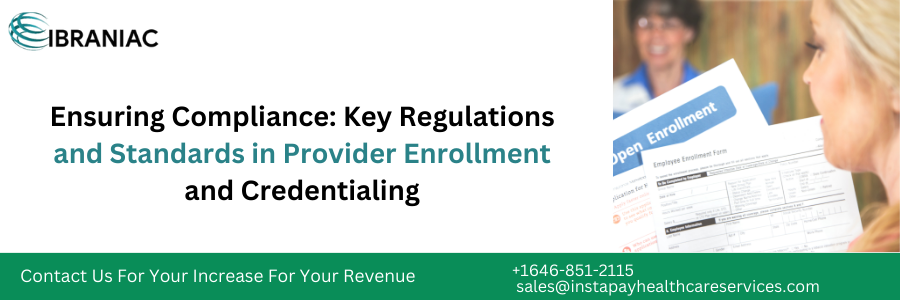
Ensuring Compliance: Key Regulations and Standards in Provider Enrollment and Credentialing
by admin | March 27, 2024 | 0 comments,
1) Introduction
In the ever-evolving landscape of healthcare,
2) Introduction to Provider Enrollment and Credentialing :
Provider enrollment includes the formal technique by which healthcare experts, facilities, and organizations practice to turn out to be affiliated with coverage networks or government healthcare programs. On the opposite hand, credentialing is the technique of verifying a healthcare provider's qualifications, experience, and competence to make certain they meet the requirements set by means of regulatory groups and accrediting our bodies.
3) Importance of Compliance in Provider Enrollment and Credentialing
Compliance in provider enrollment and credentialing is paramount to uphold patient protection, shield against fraud and abuse, and maintain the integrity of healthcare transport structures. Non-compliance can cause felony consequences, lack of repayment, and compromised patient care.
4)Overview of Key Regulations in Provider Enrollment and Credentialing
Federal Regulations
CMS Regulations
The Centers for Medicare & Medicaid Services (CMS) sets forth policies governing provider enrollment in federally funded healthcare programs consisting of Medicare and Medicaid. These policies outline eligibility standards, enrollment methods, and ongoing compliance requirements.
5) HIPAA Regulations
The Health Insurance Portability and Accountability Act (HIPAA) establishes requirements for defensive sensitive affected person facts. Healthcare vendors need to follow HIPAA policies during the credentialing system to protect affected person privateness and protection.
6) State Regulations
In addition to federal guidelines, states may impose their personal requirements for provider enrollment and credentialing. These rules range by means of nation and might include licensing requirements, historical past exams, and scope of exercise recommendations.
7) Accreditation Standards
Accrediting our bodies along with the National Committee for Quality Assurance (NCQA) and the Utilization Review Accreditation Commission (URAC) set requirements for healthcare businesses' credentialing techniques. Compliance with accreditation standards demonstrates a dedication to first-class and patient protection.
8) Understanding Provider Enrollment Process
The provider enrollment process commonly involves completing an application, filing supporting documentation, and present process verification and screening methods. Providers should adhere to precise timelines and necessities to make certain an easy enrollment procedure.
9) Ensuring Compliance with Regulations and Standards
To preserve compliance, healthcare corporations should adhere to documentation necessities, conduct ongoing tracking and auditing of company credentials, and promptly cope with any problems or discrepancies that arise.
10) Challenges in Compliance Management
Managing compliance in provider enrollment and credentialing poses several demanding situations, along with staying abreast of regulatory modifications, ensuring information security and integrity, and navigating resource constraints including staffing and budget boundaries.
11) Best Practices for Compliance in Provider Enrollment and Credentialing
Implementing technology answers along with credentialing software program can streamline strategies and decorate accuracy and efficiency. Additionally, making an investment in education and training applications for staff and fostering collaboration and communication among stakeholders can help mitigate compliance risks.
FAQs
What are the consequences of non-compliance in provider enrollment and credentialing?
Non-compliance can bring about felony penalties, lack of reimbursement, and compromised patient care.
How do accreditation standards contribute to compliance in provider enrollment?
Accreditation standards set forth with the aid of agencies like NCQA and URAC provide benchmarks for credentialing techniques, ensuring consistency and high-quality in healthcare delivery.
What role does technology play in ensuring compliance in provider enrollment and credentialing?
Technology answers including credentialing software program streamline methods, enhance accuracy, and facilitate ongoing tracking and auditing of provider credentials.
How can healthcare organizations stay informed about regulatory changes in provider enrollment and credentialing?
Healthcare organizations can subscribe to regulatory updates, participate in enterprise forums, and have interaction with expert associations to stay abreast of regulatory modifications.
Why is ongoing monitoring and auditing important in compliance management?
Ongoing monitoring and auditing assist healthcare organizations perceive and address compliance troubles proactively, minimizing risks and making sure ongoing adherence to regulations and requirements.
Conclusion
Ensuring compliance with policies and requirements is crucial for powerful provider enrollment and credentialing. By know-how and adhering to key guidelines, leveraging generation solutions, and adopting great practices, healthcare corporations can guard patient safety, mitigate risks, and uphold the best requirements of care delivery.